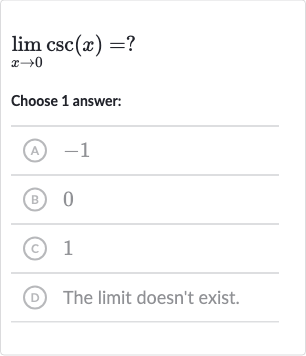Full solution
Q. Choose answer:(A) (B) (C) (D) The limit doesn't exist.
- Define : We know that is the reciprocal of , so . To find the limit of as approaches , we need to consider the behavior of near .
- Consider behavior: Since , the reciprocal will become very large as approaches . This means that the limit of as approaches is not finite.
- Reciprocal becomes large: We must also consider the behavior from both sides of . As approaches from the positive side, is positive, and thus is positive and grows without bound. As approaches from the negative side, is negative, and thus is negative and decreases without bound.
- Behavior from both sides: Since the behavior of as approaches from the positive and negative sides is not consistent (it does not approach a single finite number), the limit does not exist.
More problems from Inverses of sin, cos, and tan: degrees
QuestionGet tutor help
QuestionGet tutor help
QuestionGet tutor help
QuestionGet tutor help
QuestionGet tutor help
QuestionGet tutor help
Question
. Find the value of in degrees.Write your answer in simplified, rationalized form. Do not round.____
Get tutor helpQuestionGet tutor help

